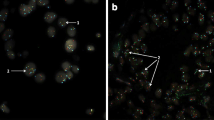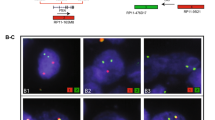Abstract
The prognostic value of phosphatase and tensin homolog (PTEN) loss in prostate cancer has primarily been evaluated by either fluorescence in situ hybridization (FISH) or immunohistochemistry (IHC). Previously, we found that PTEN loss by IHC was associated with increased risk of upgrading from biopsy (Gleason 3 + 3) to prostatectomy (Gleason 7+). Now, using an evaluable subset of 111 patients with adjacent biopsy sections, we analyzed the association between PTEN deletion in cancer and the odds of upgrading by a highly sensitive and specific four-color FISH assay. We also compared the concordance of PTEN loss by IHC and PTEN deletion by FISH. PTEN deletion was found in 27 % (12/45) of upgraded cases compared with 11 % (7/66) of controls (P = 0.03). Cancers with PTEN deletions were more likely to be upgraded than those without deletions (adjusting for age odds ratio = 3.40, 95 % confidence interval 1.14–10.11). With respect to concordance, of 93 biopsies with PTEN protein detected by IHC, 89 (96 %) had no PTEN deletion by FISH, and of 18 biopsies without PTEN protein by IHC, 15 had homozygous or hemizygous PTEN deletion by FISH. Only 4 biopsies of the 93 (4 %) with PTEN protein intact had PTEN deletion by FISH. When the regions of uncertainty in these biopsies were systematically studied by FISH, intra-tumoral variation of PTEN deletion was found, which could account for variation in immunoreactivity. Thus, FISH provides a different approach to determining PTEN loss when IHC is uncertain. Both FISH and IHC are concordant, showing consistent positive associations between PTEN loss and upgrading.



Similar content being viewed by others
References
Verhagen PCMS, van Duijn PW, Hermans KGL et al (2006) The PTEN gene in locally progressive prostate cancer is preferentially inactivated by bi-allelic gene deletion. J Pathol 208(5):699–707. doi:10.1002/path.1929
Yoshimoto M, Cunha IW, Coudry a RA et al (2007) FISH analysis of 107 prostate cancers shows that PTEN genomic deletion is associated with poor clinical outcome. Br J Cancer 97(5):678–685. doi:10.1038/sj.bjc.6603924
Reida HM, Attard G, Ambroisine L et al (2010) Molecular characterisation of ERG, ETV1 and PTEN gene loci identifies patients at low and high risk of death from prostate cancer. Br J Cancer 102(4):678–684. doi:10.1038/sj.bjc.6605554
Krohn A, Diedler T, Burkhardt L et al (2012) Genomic deletion of PTEN is associated with tumor progression and early PSA recurrence in ERG fusion-positive and fusion-negative prostate cancer. Am J Pathol 181(2):401–412. doi:10.1016/j.ajpath.2012.04.026
Burdelski C, Reiswig V, Hube-Magg C et al. (2015) Cytoplasmic accumulation of sequestosome 1 (p62) is a predictor of biochemical recurrence, rapid tumor cell proliferation and genomic instability in prostate cancer. Clin Cancer Res 1. doi:10.1158/1078-0432.CCR-14-0620.
Troyer DA, Jamaspishvili T, Wei W et al. (2015) A multicenter study shows PTEN deletion is strongly associated with seminal vesicle involvement and extracapsular extension in localized prostate cancer. Prostate :n/a - n/a. doi:10.1002/pros.23003.
Sircar K, Yoshimoto M, Monzon FA et al (2009) PTEN genomic deletion is associated with p-Akt and AR signalling in poorer outcome, hormone refractory prostate cancer. J Pathol 218(4):505–513. doi:10.1002/path.2559
Cuzick J, Yang ZH, Fisher G et al (2013) Prognostic value of PTEN loss in men with conservatively managed localised prostate cancer. Br J Cancer 108(12):2582–2589. doi:10.1038/bjc.2013.248
Boström PJ, Bjartell AS, Catto JWF et al. (2015) Genomic predictors of outcome in prostate cancer. Eur Urol. doi:10.1016/j.eururo.2015.04.008.
Punnen S, Freedland SJ, Presti JC et al (2014) Multi-institutional validation of the CAPRA-S score to predict disease recurrence and mortality after radical prostatectomy. Eur Urol 65(6):1171–1177. doi:10.1016/j.eururo.2013.03.058
Mithal P, Allott E, Gerber L et al. (2014) PTEN loss in biopsy tissue predicts poor clinical outcomes in prostate cancer. Int J Urol.
Lotan TL, Carvalho FL, Peskoe SB et al (2014) PTEN loss is associated with upgrading of prostate cancer from biopsy to radical prostatectomy. Mod Pathol 28(1):1–10. doi:10.1038/modpathol.2014.85
Shah RB, Bentley J, Jeffrey Z, Demarzo AM (2015) Heterogeneity of PTEN and ERG expression in prostate cancer on core needle biopsies: implications for cancer risk stratification and biomarker sampling. Hum Pathol 46(5):698–706. doi:10.1016/j.humpath.2015.01.008
Yoshimoto M, Ludkovski O, Degrace D et al (2012) PTEN genomic deletions that characterize aggressive prostate cancer originate close to segmental duplications. Genes Chromosom Cancer 51(2):149–160. doi:10.1002/gcc.20939
Epstein JI, Allsbrook WC, Amin MB, Egevad LL (2006) Update on the Gleason grading system for prostate cancer: results of an international consensus conference of urologic pathologists. In: Advances in Anatomic Pathology 13:57–59. doi:10.1097/01.pap.0000202017.78917.18.
Pound CR, Partin AW, Eisenberger MA, Chan DW, Pearson JD, Walsh PC (1999) Natural history of progression after PSA elevation following radical prostatectomy. JAMA 281(17):1591–1597. doi:10.1097/00005392-199910000-00103
Ventura RA, Martin-Subero JI, Jones M et al (2006) FISH analysis for the detection of lymphoma-associated chromosomal abnormalities in routine paraffin-embedded tissue. J Mol Diagn 8(2):141–151. doi:10.2353/jmoldx.2006.050083
Lotan TL, Gurel B, Sutcliffe S et al (2011) PTEN protein loss by immunostaining: analytic validation and prognostic indicator for a high risk surgical cohort of prostate cancer patients. Clin Cancer Res 17(20):6563–6573. doi:10.1158/1078-0432.CCR-11-1244
Song MS, Salmena L, Pandolfi PP (2012) The functions and regulation of the PTEN tumour suppressor. Nat Rev Mol Cell Biol 13(5):283–296. doi:10.1038/nrm3330
Hoogland AM, Kweldam CF, Van Leenders GJLH (2014) Prognostic histopathological and molecular markers on prostate cancer needle-biopsies: a review. Biomed Res Int 2014:1–12. doi:10.1155/2014/341324
Krohn A, Freudenthaler F, Harasimowicz S et al. (2014) Heterogeneity and chronology of PTEN deletion and ERG fusion in prostate cancer. Mod Pathol :1–9. doi:10.1038/modpathol.2014.70.
Gumuskaya B, Gurel B, Fedor H et al (2013) Assessing the order of critical alterations in prostate cancer development and progression by IHC: further evidence that PTEN loss occurs subsequent to ERG gene fusion. Prostate Cancer Prostatic Dis 16(2):209–215. doi:10.1038/pcan.2013.8
Yoshimoto M, Ding K, Sweet JM et al. (2013) PTEN losses exhibit heterogeneity in multifocal prostatic adenocarcinoma and are associated with higher Gleason grade. Mod Pathol 1–13. doi:10.1038/modpathol.2012.162.
Wolff AC, Hammond MEH, Hicks DG et al (2013) Recommendations for human epidermal growth factor receptor 2 testing in breast cancer: American Society of Clinical Oncology/College of American Pathologists clinical practice guideline update. J Clin Oncol 31(31):3997–4013. doi:10.1200/JCO.2013.50.9984
Acknowledgments
Funding for this research was provided in part by a Prostate Cancer Foundation Young Investigator Award (TLL), a grant from David Koch administered by the Patrick C. Walsh Prostate Cancer Research Fund (TLL), and the NIH/NCI Prostate SPORE P50CA58236. TV was supported by Coordenação de Aperfeiçoamento de Pessoal de Nivel Superior (CAPES) in Brazil. JAS and CGPA were supported by the Conselho Nacional de Desenvolvimento Científico e Tecnológico (CNPq) in Brazil.
Author information
Authors and Affiliations
Corresponding author
Ethics declarations
Conflicts of interest
Jeremy Squire has consulted for CymoGenDx LLC.
Electronic supplementary material
Below is the link to the electronic supplementary material.
ESM 1
(DOCX 21 kb)
Rights and permissions
About this article
Cite this article
Picanço-Albuquerque, C.G., Morais, C.L., Carvalho, F.L.F. et al. In prostate cancer needle biopsies, detections of PTEN loss by fluorescence in situ hybridization (FISH) and by immunohistochemistry (IHC) are concordant and show consistent association with upgrading. Virchows Arch 468, 607–617 (2016). https://doi.org/10.1007/s00428-016-1904-2
Received:
Revised:
Accepted:
Published:
Issue Date:
DOI: https://doi.org/10.1007/s00428-016-1904-2




